From some of the most acclaimed historic German wineries to stunning historic landmarks, the wine capital of Franconia is a wonderful gem not to be missed.
When it comes to the most beautiful destinations to visit in Germany, somehow the small city of Würzburg continues to be overlooked by many. Yet this beautiful Franconian city has a lot that plays in its favour.
Nestled along both sides of the Main River and framed by lush green vineyards, Würzburg is home to an old town centre with many beautiful historic buildings dating back to various epochs, an UNESCO World Heritage Site, a large number of churches and cathedrals (Würzburg is actually called the ‘city of 100 churches’), a huge fortress towering over the city, some interesting museums… and of course it’s excellent renowned local wineries.
Fun fact: Did you know that it was in Würzburg that Wilhelm Conrad Röntgen discovered X-rays for which he later was awarded a Nobel Price?
At least for wine lovers, Würzburg is indeed the centre of Germany’s Franken wine region. Some of the areas’ most historic and iconic wineries are located directly within the city, while many more are just a stone’s throw away in the beautiful nearby countryside.

Thus, Würzburg is not only the perfect place to enjoy the excellent local Franken wines among stunning historic landmarks and vineyard views. It’s also a perfect gateway to the many stunning small Franconian wine towns lining the Main River.
If you enjoy combining fantastic culinary experiences with stunning history, don’t miss beautiful Würzburg and its surrounding vineyards.
Exploring the famous wineries of Würzburg
It might be over the top to claim Würzburg is ruled by wine, but without any question wine is a very present scheme throughout this beautiful city. After all, it’s home to three of the oldest and largest German wineries, and one of the country’s most acclaimed Grosse Lage vineyards – the famous Würzburger Stein.
If you love to combine outstanding wine experiences with amazing historic architecture, Würzburg is the perfect place to spend some time.

By the way, Franconia (or Franken in German) is the only wine region in Germany using the famous local Bocksbeutel, a wine bottle shaped like a ‘bucks’ sack.
Staatlicher Hofkeller
The amazing story of one of the worlds’ oldest wineries goes back to the year 1128 when Bishop Embricho of Würzburg granted a site to Brothers Johannes and Heinrich along with their fellow friars to build their own cloister. This also marked the birth of the cloisters’ own winery, Fürstbischöfliche Hofkeller (Prince Bishop Winery). Over time, the name changed a couple of times to reflect the respective ownership, with the winery always belonging to the governing body of Würzburg and later Bavaria.

The latest name change came in 1918 with the passing under the ownership of the State of Bavaria, and since the winery is known as Staatlicher Hofkeller.
The historic wine cellar Residenzweinkeller is located deep below the historic stately Würzburg Residenz and with its beautifully illuminated extensive and labyrinthine corridors and vaults, it’s truly one of the most stunning in the world.
Building a wine cellar was indeed one of the main features the Prince Bishop of Würzburg, Johann Philipp Franz von Schönborn, demanded from architect Balthasar Neumann when starting the construction of the impressive complex in 1719.

Meanwhile, the modern and sleek Hofkeller Vinothek, the winery’s tasting room is located just across the road from the Residenz complex, in the historic Rosenbachpalais at Residenzplatz 3.
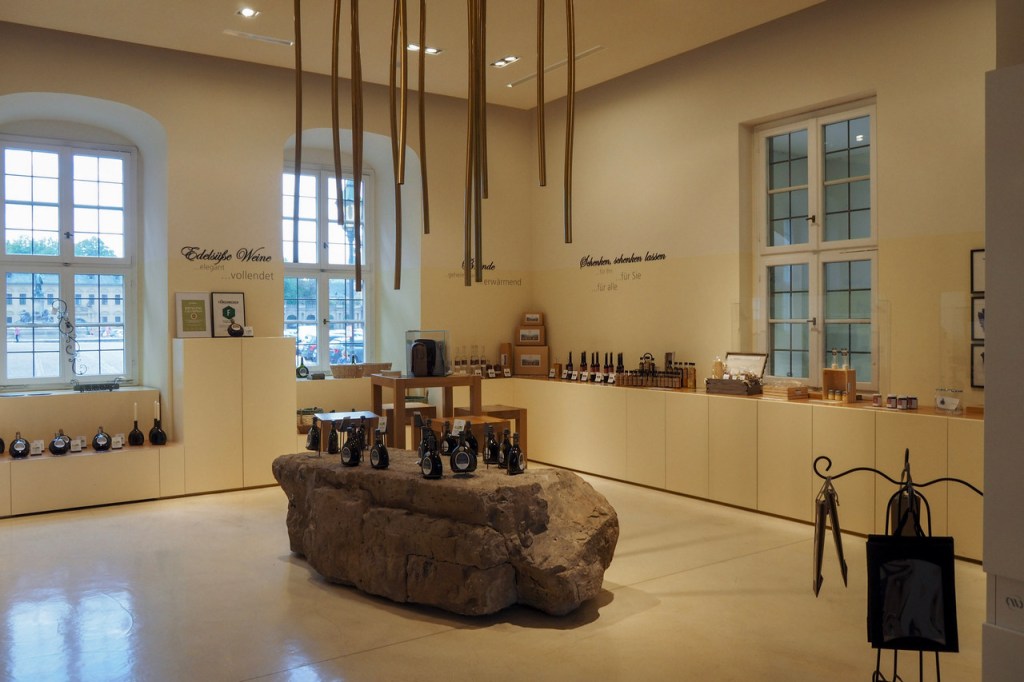
I definitely recommend starting your day in Würzburg with a morning visit to the Residenz (see below for what to expect), followed by a tour through the historic wine cellar. Then head over to the Vinothek for another flight of the winery’s excellent wines before heading to lunch somewhere in the city.
In fact, for lunch head to the excellent Bürgerspital Restaurant to continue your wine experience at yet another of the city’s historic wineries.
Bürgerspital Winery
If you want to admire the oldest bottles of white wine in the world, head to Bürgerspital winery. The historic wine cellar still stores bottles of the 1540 Steinwein (translating into stone wine, which alludes to famous Würzburger Stein vineyard).
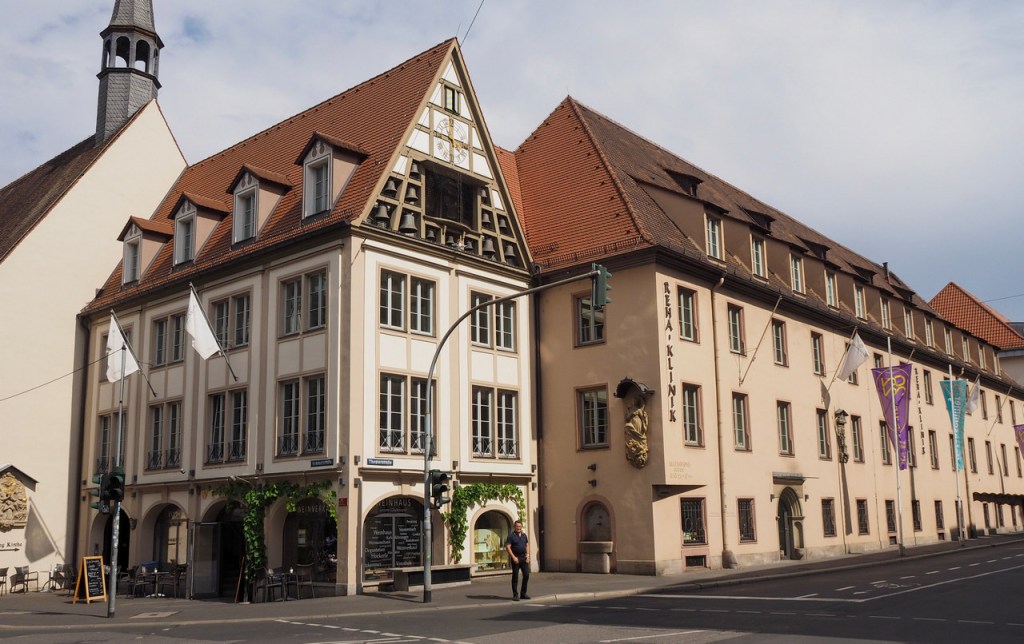
Founded in 1316 as major charitable institution of Würzburg, operating various senior citizens homes, senior citizen day care and further support for the elderly still today, wine has always played a major part of Bürgerspital. In fact, in the early days, wine was made for the inhabitants of Bürgerspital who had the right to receive one measure of wine (1.22 litres). Today, wine sales are still a major contribution to the foundation’s social commitment.

With 120 hectares under vine, Bürgerspital is the second largest winery in Franken (and one of the largest in Germany) growing Silvaner, Riesling and Burgundy grapes. Most of the wines are still bottled in the famous local ‘Bocksbeutel’ bottle.
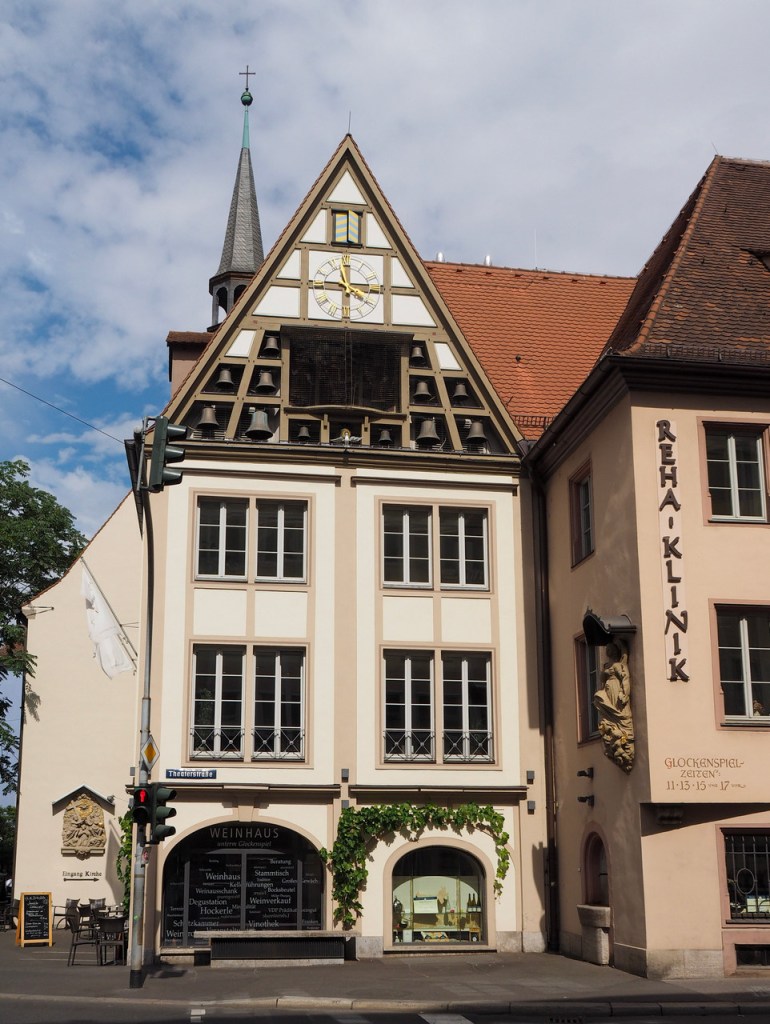
The beautiful tasting room ‘Weinhaus unterm Glockenspiel’, literally meaning wine house below the bell chimes, is well worth a visit. And being open seven days a week it is one of the few tasting rooms of Franken wineries open on Sundays too.
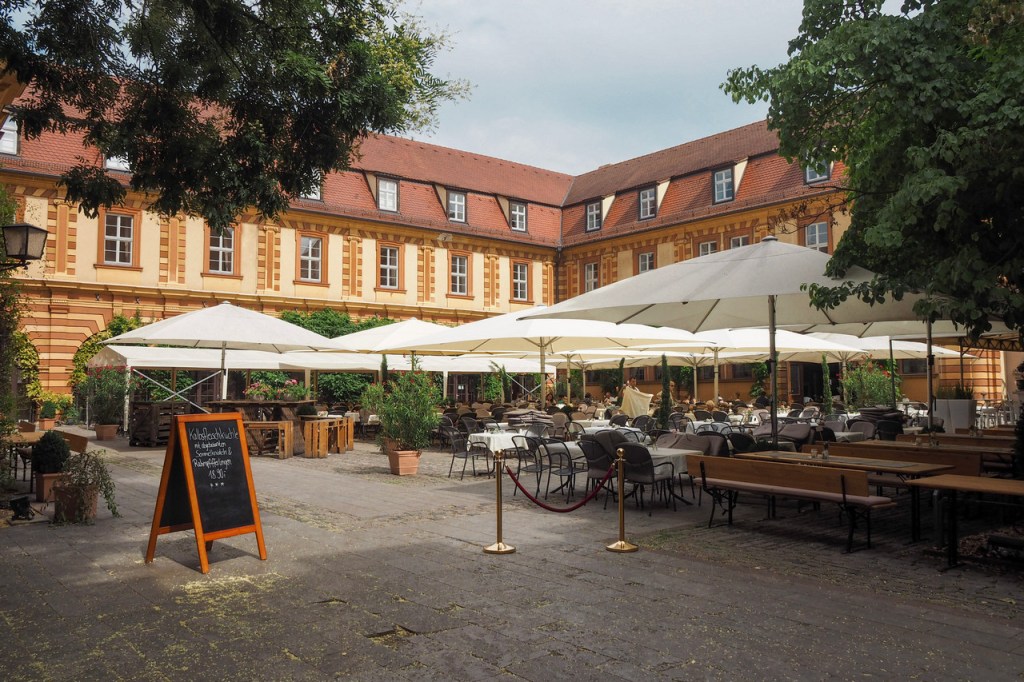
Just around the corner, Bürgerspital’s Restaurent Weinstuben serves traditional local Francian food along with the wines from the winery. On warm days, food will be served in the beautiful courtyard which is a favourite spot in town for both locals and tourists.
Both the Weinhaus and Weinstuben are located in the Bürgerspital complex spanning Semmelstraße and Theaterstraße.
Juliusspital Winery
Much like Bürgerspital but founded much later (in 1576) by Princely-Bishop Julius Echter von Mespelbrunn, Juliusspital Foundation too has a charitable mission, including a hospital, a senior citizens home and a hospice and palliative home. And from day one Juliusspital Winery also formed part of the institution, with the profits generated from the winery contributing to the charity.

Juliusspital winery today is known as the largest Silvaner winery in the world. With around 180 hectares under vine, it is also Germany’s second largest winery and next to Silvaner (which makes 40% of all grape varieties) Juliusspital grows a large range of grapes, including Müller-Thurgau, Riesling, Pinot, Blanc, Pinot Gris, and Pinot Noir along with Traminer and Muskateller.

While vineyards are located throughout the whole Franken wine area, the winery itself is still located in the centre of Würzburg. Calling the stately Fürstenbau mansion and the 200-metre-long historic wooden barrel cellar its home, Juliusspital today adopts the latest modern technology to make wine.

The beautiful tasting room (Vinothek) Weineck Julius Echter sits at Koellikerstrasse 1a, just around the corner of the Juliusspital mansion.
Meanwhile, Restaurant Weinstuben Juliusspital is located directly on Juliuspromenade.
Weingut am Stein
Famous vineyard Würzburger Stein is undoubtedly one of the best appellations across Germany, and the winery with the tantamount name Weingut am Stein is located exactly in the midst of this outstanding location.
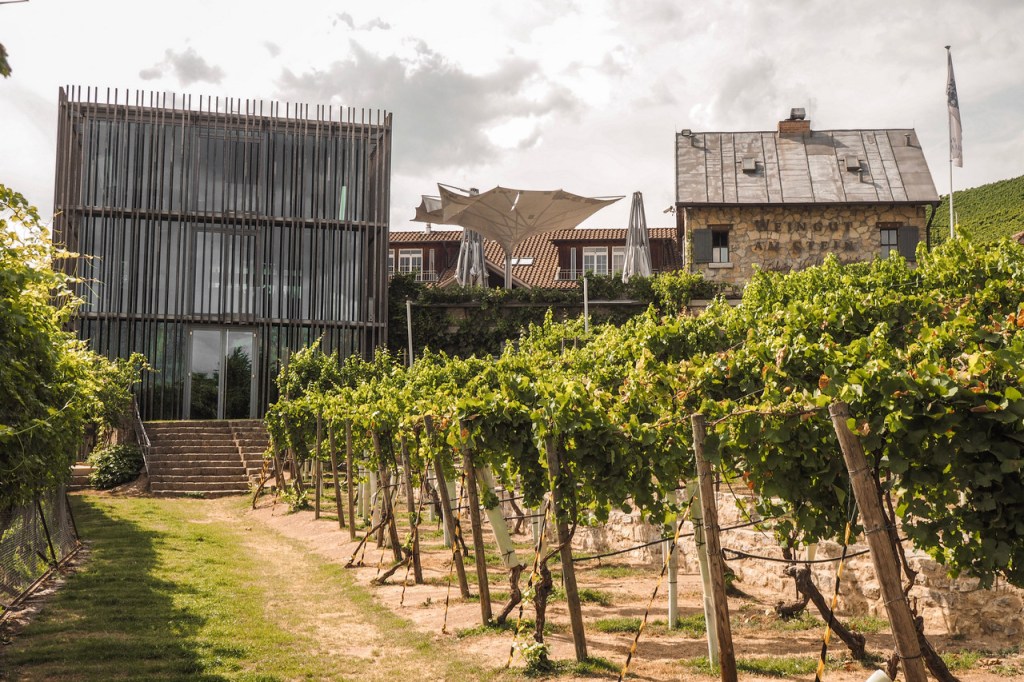
While Weingut am Stein owns only a small portion of the vineyard, which is largely owned by the three leading historic Würzburg wineries, Staatlicher Hofkeller, Bürgerspital and Juliusspital, the winery calls a number of other quality vineyards their own (or rather owns portions of appellations such as Stettener Stein and Randersacker Sonnenstuhl.
But it’s not just outstanding wines luring visitors to the winery. Architecture plays a huge role here too.

Built in 2005, the modern cubes housing the tasting room and a guesthouse offering accommodation for up to 6 people are stunning eyecatcher, while the stone clad cellar building beautifully completes the picture.

The winery is also home to one of the most renowned restaurants of the area, Michelin-starred Reisers am Stein. Sadly, it’s the restaurants last months as chef Bernhard Reiser after 20 years at the location has decided to close his restaurant (in April 2023). But given the popularity of the spot and the winery’s mission to combine good wine with good food, it’s probably not long before opening the doors of the restaurant with a new offer again. So watch this space; I will definitely do!
Exploring Würzburg beyond wine
Würzburg is not called ‚the centre of Franconian wine’ for no reason. But this beautiful small city located in the northwest of Bavaria, has a lot more to offer.
The list below is by no means complete, but when you are planning to visit Würzburg for the first time, make sure to explore the city’s most stunning locations.
Fürstbischöfliche Residenz and Hofgarten

Build after plans from famous architect Balthasar Neumann, the Princely Residence was added to list of UNESCO World Heritage Sites in 1981 as only the third building in Germany listed. Built over a period of 24 years and completed in 1744 the former seat of the Princely Bishop of Würzburg is one of the most important baroque complexes north of the Alps.
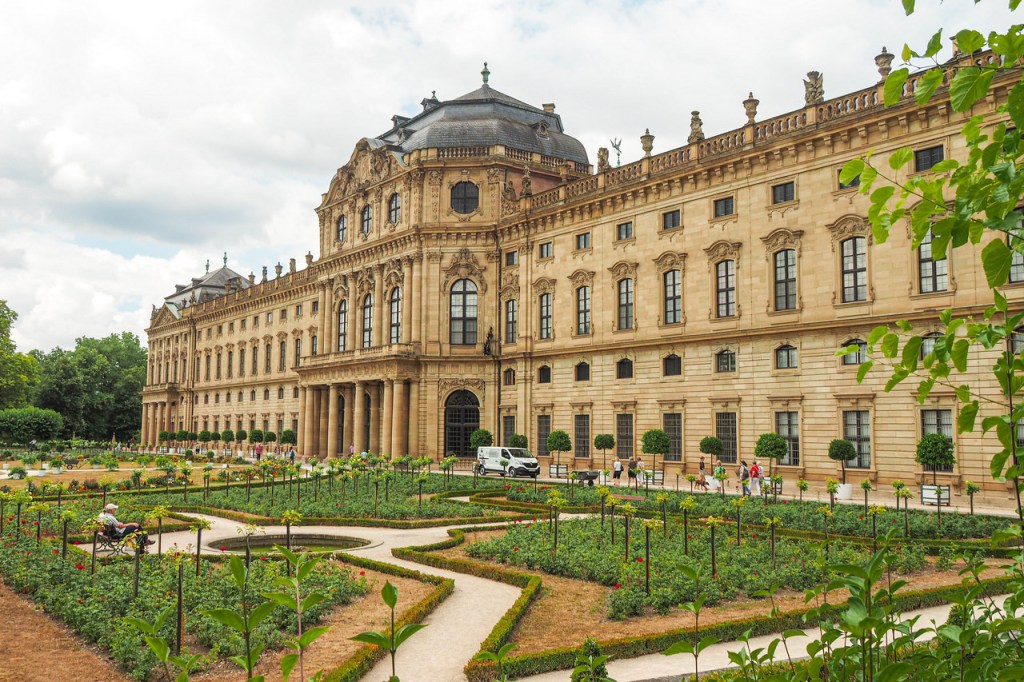
Inside marvel at the stupendous staircase with a self-supporting vault and the largest existing continuous fresco in the world painted by Giovanni Battista Tiepolo along with many other beautiful frescos throughout the complex by various artists.

Not to be missed is the stunning Hofgarten (court garden) with beautiful ramparts, rococo sculptures and cast-iron gates.
Old Main Bridge (Alte Mainbrücke)

Built originally in the 12th century, Old Main Bridge is believed to be the oldest bridge crossing the Main River, and still today some parts of the bridge are dating back to the origins.

The twelve statues deployed along the 185-metre-long bridge are known as ‘saints of the bridge’ though not all of them actually represent a saint, several are important historic local personalities.

History aside, the main reason for many to visit the bridge is the ‘Brückenschoppen’ which means to enjoy a glass of local Franken wine which traditionally was served in .25 litre glasses locally known as Schoppen. Thanks to this tradition, the bridge is also known as Wine Bridge.

Würzburg Town Hall

Grafeneckart, the 55-metre-high tower of Würzburg’s stunning old Town Hall is the oldest part of the building, one of the most important and definitely most beautiful monuments of Würzburg.

The Romanesque tower dating back to the 13th century is also the only part of the building that was not destroyed during the second world war, while the remaining part of the town hall was later on reconstructed.
Würzburg St. Kilians Cathedral (Dom)

The fourth-largest Romanesque cathedral in Germany, St. Kilians Cathedral surprises with a unique design. While the most eye-catching part are the tall twin towners, the narrow building stretches over 150 metres in length. The original building dates back to the 11th and 12th century and today is home to many artifacts from different centuries.
Wallfahrtskirche Mariä Heimsuchung – Käppele
Nestled on top of Nikolausberg is the stunning baroque Pilgrimage Church Maria Heimsuchung is commonly called Käppele.

Initially built as a small chapel in 1650, the structure was later expanded and adjacent to the original building a larger church was built between 1748 and 1750 after designs by Balthasar Neumann, who also built the amazing Residenz.
Though it’s possible to approach the church by car an public transport, you should definitely take the 250 steps up the historic staircase which in the 18th century was built as part of the pilgrimage route, laid out in the form of terrasses.
Festung Marienberg
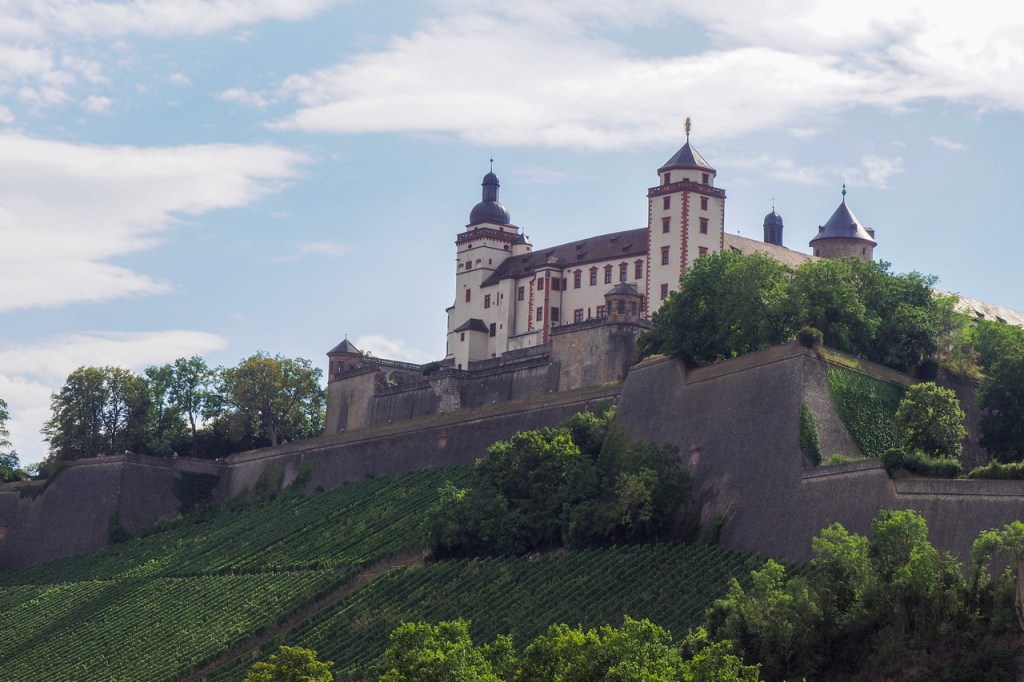
Built on the site of an ancient celtic palisade castle and visible from nearly any point of the city, the stunning fortress perched high over the Main River was originally planned to be a church. In fact, in 704 AD the first church of Würzburg was built here. However, at the start of the 13th century fortification were added around the structure turning it into a fortress.

Marienkirche: one of the oldest round churches in Germany.

The small Fürstengarten (princes garden) offers stunning views over the city.
How to get to Würzburg and how best getting around in Würzburg
Würzburg is located in the Franconia region in northern-western Bavaria, about one hour south of Frankfurt at the intersection of two major German motorways, A3 and A7. The city is also a major node of Germany’s ICE fast train network with connections to all other major cities throughout the country.
Würzburg is small enough to be discovered in two days and the historic town centre is perfectly walkable, so the best way to explore the city is walking.
Which is perfect considering the many opportunities to taste some of the local wines. Thus, you do not need to worry about a designated driver.
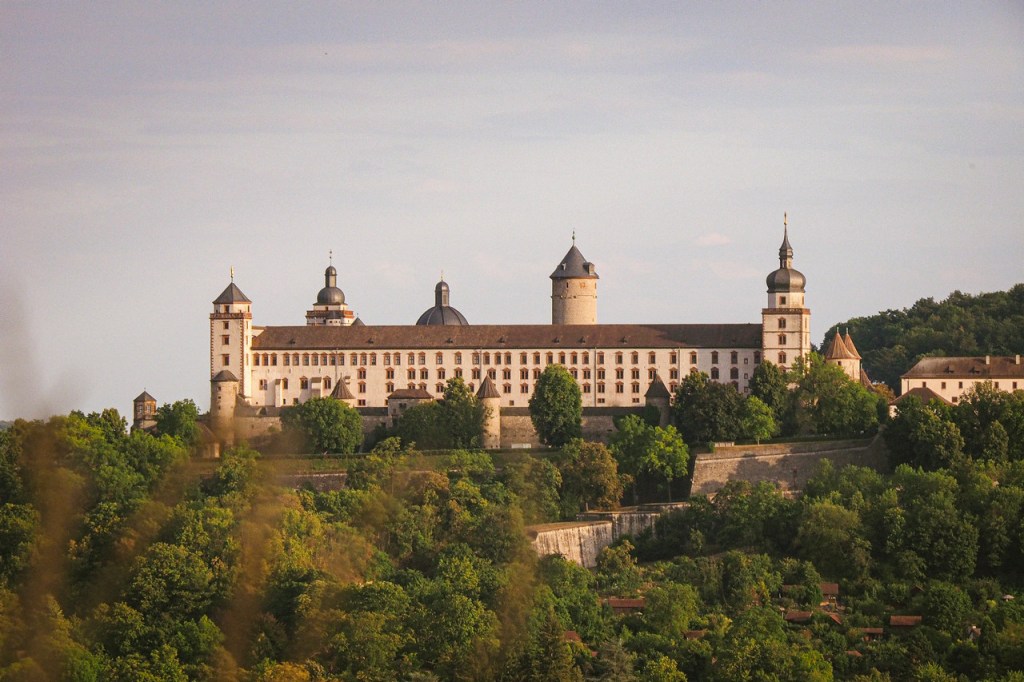
Have you already been to Würzburg or the nearby Franconian wine region? Let me know about your experience.
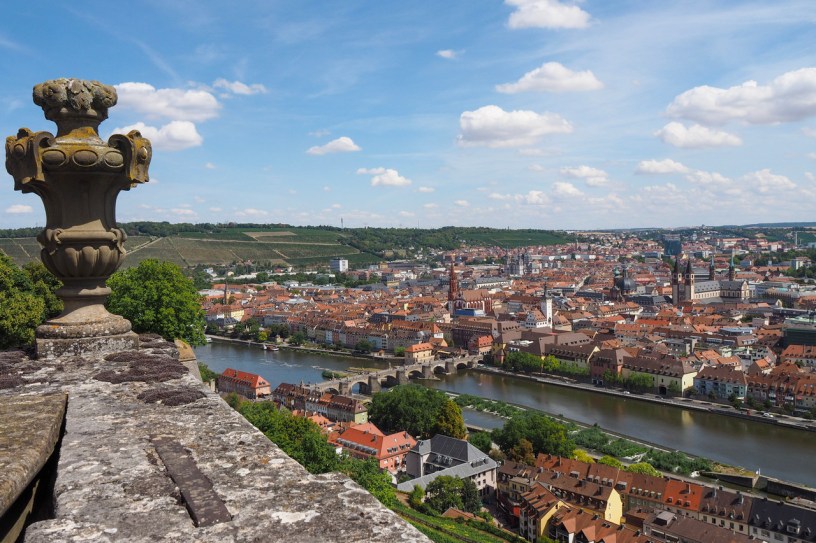
Thanks for sharing this comprehensive guide! All those breweries look amazing. It’s my first time seeing riesling in Bocksbeutel. At first, I mistook it for some medicinal drinks 😛
LikeLike
Hello – where would you stay for a day steeped in idyllic wine tasting?? we do Napa in the US often and are coming from Munich/Nuremberg…
LikeLike
Hi Bridgette, the Würzburg wine area (Franken) is not too far from Nuremberg. If you are looking for a nice stay combined with some wine experience, Steinburg Castle Hotel in Würzburg is a great location. It’s only about 5 minutes walking distance from Weingut Am Stein, one of the leading Franken wineries. Or you could try to book the winery’s guest house. Or yet another alternative would be to go out into the countryside and stay in one of the small wine towns close to Würzburg. Hotel and Winery Meintzinger in the small town of Frickenhausen is a great location.
LikeLike